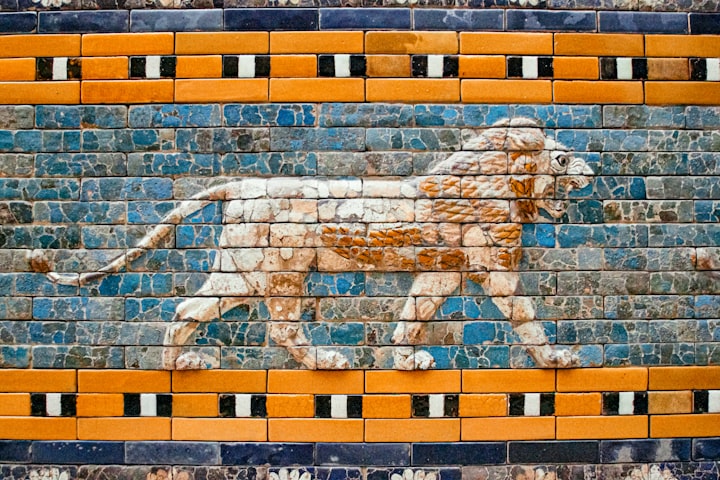The Lions of Ancient Antiquity
Mycenae, Nineveh, Babylon

LION GATE
The approach to Mycenae is substantial and if you were not a friend, it was going to be tough to get in. Mycenae is one of the great citadels of Mycenaean Culture, during the Bronze Age, located on mainland Greece. Mycenae traded throughout the Mediterranean and became quite wealthy and quite powerful between the years of bout 1600 and 1100 BCE. There were several cultures that thrived in this area during the Bronze Age period. One is Cycladic, located on the Cycladic islands. The other is the Minoan Culture, which was on the island of Crete.
Mycenae is located on the top of a small mountain. It is a very steep approach and so it is naturally defensible. In fact, there are two larger mountains on the back, and a huge valley leading down to the Aegean Sea in front. An enemy's approach could be seen from a great distance. As visitors walk up the rampway towards the entrance to Mycenae, they are surrounded by enormous blocks of stones creating very high walls on either side. The term Cyclopean Masonry, based on the mythic giant, Cyclops, is used to describe the Mycenean's Large stone construction technique.

The entrance to Mycenae is referred to as the Lion Gate. The triangular space of the Lion Gate is formed by the corbelling of the wall and is supported by the post and lintel construction of the doorway. Post and lintel construction rely on a horizontal element laid flat across the top of two supporting vertical elements. In this example, the doorway is a post and lintel structure supporting the corbelled wall above.
The relive above the Lion Gate is the first monumental sculpture that was found on mainland Greece. The central column of the Lion Gate may reflect the influence of the Minoan Culture. The column in the Lion Gate recalls the Minoan architectural style in its capital and the tapering of the shaft. There has been speculation regarding the significance of the elements in the stone relief. Some scholars have suggested the lion figures originally had bird heads. Following the ancient tradition of having powerful animals standing guard at a gate; warding off evil. These animals have been humanized in the way they are depicted; with forepaws resting on the altars. This could be a representation of the merging of two cultures.
KILLING LIONS
Assyrian civilization is named after the central god - Assur. It had a highly organized government centered on the king and dominated Mesopotamia and all of the Near East for the first half of the first millennium. Just as the empire was centered on the capital city, the capital city was really the palace of the king and its extended grounds. Many kings constructed their own capitals, related to, but at some distance from, those of their predecessors. Others chose to either stay in the same location as their immediate ancestor or to move back to a formal capital and renovate it. Nineveh was a particularly popular location, functioning as the capital of several famous Assyrian kings.
As a result of fierce and successful military campaigns, the Assyrians acquired massive resources from all over the Near East, making the Assyrian kings very rich. The palaces were on an entirely new scale of size and glamor and Assyrian art was unabashedly the art of the empire. Much of the art and architecture expressed militaristic themes. Palaces and capitals presented towers and walls that looked like highly defensible ramparts. Ultimately, the reign of the Assyrians ended under Ashurbanipal at Nineveh.
The Neo-Assyrian empire began to unravel due to a series of bitter civil wars, and Assyria was attacked by the Babylonians and Medes. From about 616 BCE, in a coalition with the Scythians and Cimmerians, they besieged Nineveh, sacking the town in 612, and later razed it to the ground. The Assyrian empire ended by 605 BCE, with the Medes and Babylonians dividing its colonies between them. Following its defeat in 612, the site remained largely unoccupied for centuries with only a scattering of Assyrians living amid the ruins until the Sasanian period.

The Assyrians used a form of gypsum, a type of stone known both as a fire preventative and an insulator, for the reliefs and carved it using iron and copper tools. The gypsum panels were used as orthostats; in other words, they were placed into/over the top of mudbrick walls. This makes construction go very quickly even as it has a finished, polished, permanent-looking effect. These orthostats can be found within the palace and especially in the throne room. While we will be focusing on Ashurbanipal's image programs; the lion hunt and the conquest of enemies are common themes found throughout most Assyrian palaces.
In the orthostat, Ashurbanipal (or Assurbanipal) Killing Lions, Ashurbanipal shows the controlled nature of the hunt. The lions are taken from his gardens and caged and then released so he can kill them in the ultimate statement of control. While the lion hunt itself is a common theme found in most Assyrian palaces, earlier kings are not so specific about the location of the lion hunt itself. Ashurbanipal goes to some lengths to show the dying lions, expressing a sense of pity. He does this to show that he can take something that is normally ferocious, something to be feared, and turns it into something to be pitied. He also vanquishes chaos and in doing so, orders his kingdom. The lions represent not only the forces of chaos but chaos is specifically connected with the natural world, while the king provides order, as associated with civilization. Thus, not on is the king against chaos, it is also the king as the head of ordered civilization against the unordered wilds.
THE ISHTAR GATE AND PROCESSIONAL WAY
Only one of the city gates of Babylon was so richly decorated with colored glazed bricks and animal reliefs. It comprised an outer and an inner gate. Only the smaller outer gate is reconstructed in the museum. We must imagine the inner gate as being considerably taller. The outer walls were completely covered with the glazed brick bas-reliefs, depicting a total of about 575 animals. This unique building ornamentation served as a backdrop with a cultic protective function, with the divinities thus embodied accompanying the processions which were always held for the Babylonian New Year celebrations.

Bulls and dragons alternate, beasts symbolizing the wheater god Abad and the god Marduk. Sex and war lurk here. With an upraised head, the lion strides along the walls of the Processional Way of Babylon. It symbolizes Ishtar, the goddess of love and fertility, but also of war. Ishtar was one of the most important goddesses of the ancient oriental pantheon. The Processional Way is partially reconstructed from countless colored glazed brick fragments and was once an important part of the northern entrance to the city of Babylon, leading directly to the Ishtar Gate. The 180 m of the city walls along the Processional Way are ornamented with decorative strips, rosette bands, and striding lions. The way was called 'the enemy shall not prevail' and made into such a magnificent Processional Way so that it could be the backdrop for the Babylonian New Year festival at the beginning of spring. At the close of several days of festivities, the cult images of the main Babylonian gods were drawn in a ceremonial procession along the colorfully embellished paved way back into the city.
The representation of strength and order depicted using animal imagery appears to be a common theme throughout the cultures of Babylon, Mycenae, and Assyria. While it may be used as a form of supernatural protection, it can also indicate the strength of the king or emperor who can control the power of these majestic creatures. In other ways, these beautiful animals represent deities. It is not a wonder that the lion has often been referred to as the "king of the jungle". Regardless of the purpose of this animal, it reflects a recognition and an appreciation for their fierceness, power, and strength.
About the Creator
Rebecca A Hyde Gonzales
I started writing when I was about eight years old. I love to read and I also love to create. As a writer and an artist, I want to share the things that I have learned and experienced. Genres: Fiction, non-fiction, poetry, and history.






Comments
There are no comments for this story
Be the first to respond and start the conversation.